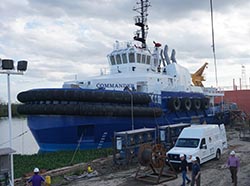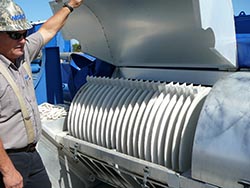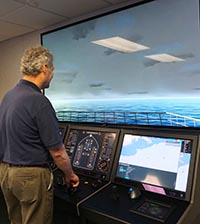Major equipment upgrades include state-of-the-art tugs, skimmers, oil-spotting technology, oil response barges

The first new Edison Chouest Offshore, or ECO, tugs to arrive in Prince William Sound are expected to be the Elrington, one of the new general purpose tugs, and the Commander, one of the new tanker escort tugs. They both launched last fall and are traveling north from the Gulf of Mexico, expected to arrive in early March. They will pick up a new, purpose-built oil spill response barge on their way past Portland, Oregon.
Update: The first tugs have arrived!
ECO is bringing a total of five new escort tugs, four new general purpose tugs, one utility and anchor handling tug, and four response barges to Alaska. As vessels and barges arrive in Prince William Sound, hands-on training and demonstrations with this equipment will start.
The Alaska Department of Environmental Conservation is expecting that each of the tugs, barges, and their associated crews will need to demonstrate their capabilities and adeptness before they can be approved for service. This process will start in March with arrival of the first pieces of equipment and continue as more equipment and crews arrive.
Sea trials
Well before arriving in Alaska, all of the tugs must undergo U.S. Coast Guard-required “sea trials,” or a testing period. The trials test speed, maneuverability, equipment, safety features, and seakeeping. “Seakeeping” is a measure of the vessel’s performance in wind and waves, which is important for crew safety and comfort. These trials will take place in the Gulf of Mexico.
The tugs intended for escort must also meet the U.S. Coast Guard regulations and standards set by the American Bureau of Shipping. These standards include “bollard pull,” which is the pulling capability of a tug. Prince William Sound tugs must be able to safely stop and steer the largest fully laden tanker in Prince William Sound in the event that it loses power or steering.
The Elrington and Commander have already completed these trials. Both tugs exceeded the bollard pull expectations for their design. The Council is awaiting further details from these tests.
All new vessels will be required to perform additional tests in Prince William Sound before the system can be officially implemented.
New imaging technologies
Several of the new tugs will carry thermal imaging systems and special radar processing technology to help spot spilled oil on the water. Other uses include: navigation at night, detecting ice from Columbia Glacier, or locating an overboard crew member in an emergency.
New purpose-built barges designed for oil spill recovery

Alyeska is getting new oil spill response barges intended for open-water environments. These barges represent the newest technology in spill response, with highly efficient oleophilic skimmers and Current Buster 8 boom systems that help separate water from oil. The barges serve as the platform to deploy this equipment, as well as providing storage for recovered oil. Improvements in the designs compared to the current response barges include:
- Oil cargo piping and pumps have been moved below deck to eliminate clutter and trip hazards.
- A large chute on the stern helps with equipment offloading and recovery.
- The barges’ decks are large enough to fully inflate and lay out the Current Buster 8 boom before deployment, saving time and improving safety.
- The oil recovery equipment is significantly more efficient.
Mariner training

Since last summer, trainers from Alyeska’s Ship Escort/Response Vessel System, or SERVS, have been working with ECO to train new crews on SERVS’ operations, Prince William Sound, and spill response equipment. Training is a mixture of classroom and hands-on training. Council staff members have attended blocks of this training as observers.
ECO captains have been traveling to Alaska to ride along with Crowley crews on tanker escorts, to see the job first hand and experience winter weather conditions in Prince William Sound. This is expected to continue through April. Tug, tanker, and pilot boat captains and crew have also gathered at AVTEC – Alaska’s Institute of Technology in Seward to work through simulations on AVTEC’s vessel simulators.